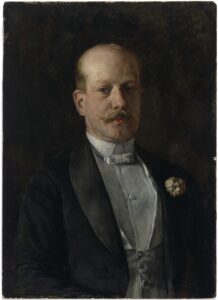 Thomas Benedict Clarke (11 December 1849–18 January 18 1931) elected 8th shepherd in 1898, was a socialite and art collector. The closest connection he had with the theater was through his son, who was briefly married to actress Elsie Ferguson. Clarke was elected to the club in 1888 as a non-theatrical member; he joined the council almost immediately. He was corresponding secretary 1889-98, and served as shepherd for two one-year terms, 1898-1900.
Thomas Benedict Clarke (11 December 1849–18 January 18 1931) elected 8th shepherd in 1898, was a socialite and art collector. The closest connection he had with the theater was through his son, who was briefly married to actress Elsie Ferguson. Clarke was elected to the club in 1888 as a non-theatrical member; he joined the council almost immediately. He was corresponding secretary 1889-98, and served as shepherd for two one-year terms, 1898-1900.
Clarke was born in Manhattan on December 11, 1849, son of Dr. George Washington Clarke, headmaster of the Mount Washington Collegiate Institute of New York, a private college on Washington Square. Clarke graduated from his father’s school. He married into society, Frances Eugenia Morris, in 1871. The couple had two children and lived in a stately home just off Fifth Avenue at 4 E. 34th St., where he displayed a significant collection of furniture, paintings, and porcelain. Clarke worked briefly in the linen and lace industry, before becoming a full-time art collector and dealer. His reputation was so valued that he was art advisor to J. P. Morgan.
A mentor to young American artists such as Winslow Homer, George Inness, and A.H. Wyant, he would haunt the studio of a promising young artist, “watching a painting from day to day as it progressed, then hurrying the canvas away as soon it was completed, lest the artist might be tempted to ‘dabble further’ and thus spoil the result.” He also was a major collector. In 1916 he paid more than $16,000 ($378,000 today) for a Gilbert Stuart painting of George Washington, known as the Vaughan Portrait. Today it is in the National Gallery of Art. He also collected antique furniture, plates, and rugs.
Curiously, his official shepherd’s portrait by wealthy socialite Samuel Montgomery Roosevelt, among the gallery of 35 shepherds in The Lambs’ clubhouse, is among the poorest in the collection. It is stiff and lacks personality, as if done from a paint-by-numbers kit. Clarke himself donated it to the club; a much more dynamic portrait by Charles Frederic Ulrich in 1884 is in the National Portrait Gallery.
Clarke was shepherd while The Lambs celebrated its silver anniversary with a gala gambol on December 24, 1899. It had been an eventful 25 years. The Lambs were poised to become the greatest theater club that America had ever seen.
During Clarke‘s tenure, heated debate took place about plans for a new Fold. With the West 36th Street Clubhouse crowded to capacity, a movement got underway to build an entirely new clubhouse further uptown. Clarke was opposed to the idea. Club records are mum about the new 44th Street Clubhouse debate; only many years later, after Clarke‘s death, did official records mention that “there was quite a controversy at the time.” This reminds us that The Lambs was a club of actors trying very hard to be gentlemen. Clarke was not by nature opposed to progress and change–in 1896 it was he, as corresponding secretary, who had submitted plans for the West 36th Street Clubhouse.
Annie Braham Harrigan, wife of Lambs’ member Edward Harrigan (of Harrigan & Hart) offered to sell the club Harrigan’s Theatre, back-to-back with the clubhouse on 35th Street, at a very reasonable price. Clarke considered this and not the 44th Street location the more reasonable choice for a larger fold. What the conservative art collector did not recognize–which the membership filled with actors did instinctively–was that times were changing and the 36th Street location was rapidly becoming a suburb of the Theatre District. In any case, after two years, Clarke was replaced by a more theatrical personality: DeWolf Hopper.
Clarke achieved a distinguished record. He established a composition prize at the National Academy of Design, of which he was a member. He was a member of the American Fine Arts Society, American Museum of Natural History, New York Yacht Club, and the New York Chamber of Commerce. For nine years Clarke served as president of the New York School of Applied Design. Clarke died January 18, 1931, at age 80. His funeral was held at the Church of the Incarnation at Madison Avenue and 35th Street. He is interred in Green-Wood Cemetery, Brooklyn.
Research was by Lamb’s historian, Lewis J. Hardee, Jr. It was written and composed by Kevin C. Fitzpatrick, club librarian.